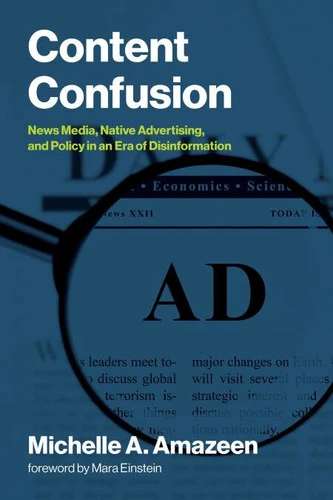Nouveauté
Content Confusion. News Media, Native Advertising, and Policy in an Era of Disinformation
Par : ,Formats :
Disponible dans votre compte client Decitre ou Furet du Nord dès validation de votre commande. Le format ePub protégé est :
- Compatible avec une lecture sur My Vivlio (smartphone, tablette, ordinateur)
- Compatible avec une lecture sur liseuses Vivlio
- Pour les liseuses autres que Vivlio, vous devez utiliser le logiciel Adobe Digital Edition. Non compatible avec la lecture sur les liseuses Kindle, Remarkable et Sony
- Non compatible avec un achat hors France métropolitaine
 , qui est-ce ?
, qui est-ce ?Notre partenaire de plateforme de lecture numérique où vous retrouverez l'ensemble de vos ebooks gratuitement
Pour en savoir plus sur nos ebooks, consultez notre aide en ligne ici
- Nombre de pages332
- FormatePub
- ISBN978-0-262-38511-4
- EAN9780262385114
- Date de parution18/11/2025
- Protection num.Adobe DRM
- Taille46 Mo
- Infos supplémentairesepub
- ÉditeurThe MIT Press
Résumé
How mainstream news organizations and advertisers contribute to and legitimize disinformation by blurring the line between ads and journalism. We often blame social media for the rampant problem of disinformation, but the truth is that mainstream news media is often equally at fault. Not only do news outlets disguise paid content to look like online news articles, a practice called "native advertising, " but new research suggests that this form of advertising even influences the real journalism that appears next to it-both perceptions of the journalism as well as its actual substance.
In Content Confusion, Michelle Amazeen explores the origins and evolution of this mainstream media practice, how it affects audiences and the industry, and what the implications are for an accurately informed democracy. For policy makers, in particular, the book highlights the longstanding principles from governmental regulation as well as industry professional codes that serve to support clear identification of the provenance of content, an issue that will no doubt intensify with the release of generative artificial intelligence in the wild.
In Content Confusion, Michelle Amazeen explores the origins and evolution of this mainstream media practice, how it affects audiences and the industry, and what the implications are for an accurately informed democracy. For policy makers, in particular, the book highlights the longstanding principles from governmental regulation as well as industry professional codes that serve to support clear identification of the provenance of content, an issue that will no doubt intensify with the release of generative artificial intelligence in the wild.
How mainstream news organizations and advertisers contribute to and legitimize disinformation by blurring the line between ads and journalism. We often blame social media for the rampant problem of disinformation, but the truth is that mainstream news media is often equally at fault. Not only do news outlets disguise paid content to look like online news articles, a practice called "native advertising, " but new research suggests that this form of advertising even influences the real journalism that appears next to it-both perceptions of the journalism as well as its actual substance.
In Content Confusion, Michelle Amazeen explores the origins and evolution of this mainstream media practice, how it affects audiences and the industry, and what the implications are for an accurately informed democracy. For policy makers, in particular, the book highlights the longstanding principles from governmental regulation as well as industry professional codes that serve to support clear identification of the provenance of content, an issue that will no doubt intensify with the release of generative artificial intelligence in the wild.
In Content Confusion, Michelle Amazeen explores the origins and evolution of this mainstream media practice, how it affects audiences and the industry, and what the implications are for an accurately informed democracy. For policy makers, in particular, the book highlights the longstanding principles from governmental regulation as well as industry professional codes that serve to support clear identification of the provenance of content, an issue that will no doubt intensify with the release of generative artificial intelligence in the wild.



